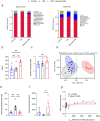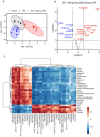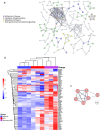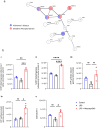A novel Mediterranean diet-inspired supplement ameliorates cognitive, microbial, and metabolic deficits in a mouse model of low-grade inflammation
- PMID: 38835220
- PMCID: PMC11155709
- DOI: 10.1080/19490976.2024.2363011
A novel Mediterranean diet-inspired supplement ameliorates cognitive, microbial, and metabolic deficits in a mouse model of low-grade inflammation
Abstract
The Mediterranean diet (MD) and its bioactive constituents have been advocated for their neuroprotective properties along with their capacity to affect gut microbiota speciation and metabolism. Mediated through the gut brain axis, this modulation of the microbiota may partly contribute to the neuroprotective properties of the MD. To explore this potential interaction, we evaluated the neuroprotective properties of a novel bioactive blend (Neurosyn240) resembling the Mediterranean diet in a rodent model of chronic low-grade inflammation. Behavioral tests of cognition, brain proteomic analysis, 16S rRNA sequencing, and 1H NMR metabolomic analyses were employed to develop an understanding of the gut-brain axis interactions involved. Recognition memory, as assessed by the novel object recognition task (NOR), decreased in response to LPS insult and was restored with Neurosyn240 supplementation. Although the open field task performance did not reach significance, it correlated with NOR performance indicating an element of anxiety related to this cognitive change. Behavioral changes associated with Neurosyn240 were accompanied by a shift in the microbiota composition which included the restoration of the Firmicutes: Bacteroidota ratio and an increase in Muribaculum, Rikenellaceae Alloprevotella, and most notably Akkermansia which significantly correlated with NOR performance. Akkermansia also correlated with the metabolites 5-aminovalerate, threonine, valine, uridine monophosphate, and adenosine monophosphate, which in turn significantly correlated with NOR performance. The proteomic profile within the brain was dramatically influenced by both interventions, with KEGG analysis highlighting oxidative phosphorylation and neurodegenerative disease-related pathways to be modulated. Intriguingly, a subset of these proteomic changes simultaneously correlated with Akkermansia abundance and predominantly related to oxidative phosphorylation, perhaps alluding to a protective gut-brain axis interaction. Collectively, our results suggest that the bioactive blend Neurosyn240 conferred cognitive and microbiota resilience in response to the deleterious effects of low-grade inflammation.
Keywords: Akkermansia; Gut-brain axis; cognition; inflammation; microbiota; neurodegenerative disease.
Conflict of interest statement
DV received funding from Activ’Inside. L.P, D.G. work for Activ’Inside and provided the Neurosyn240 extract. Activ’Inside was not involved in the design, implementation, analysis, and interpretation of the data. All the other authors have no conflict of interest to declare.
Figures







Similar articles
-
Phlorizin ameliorates cognitive and behavioral impairments via the microbiota-gut-brain axis in high-fat and high-fructose diet-induced obese male mice.Brain Behav Immun. 2025 Jan;123:193-210. doi: 10.1016/j.bbi.2024.09.008. Epub 2024 Sep 12. Brain Behav Immun. 2025. PMID: 39277023
-
Saffron extract (Safr'Inside™) improves anxiety related behaviour in a mouse model of low-grade inflammation through the modulation of the microbiota and gut derived metabolites.Food Funct. 2022 Nov 28;13(23):12219-12233. doi: 10.1039/d2fo02739a. Food Funct. 2022. PMID: 36341693
-
Supplement of microbiota-accessible carbohydrates prevents neuroinflammation and cognitive decline by improving the gut microbiota-brain axis in diet-induced obese mice.J Neuroinflammation. 2020 Mar 4;17(1):77. doi: 10.1186/s12974-020-01760-1. J Neuroinflammation. 2020. PMID: 32127019 Free PMC article.
-
Modulation of Gut Microbiota Through Dietary Intervention in Neuroinflammation and Alzheimer's and Parkinson's Diseases.Curr Nutr Rep. 2024 Jun;13(2):82-96. doi: 10.1007/s13668-024-00539-7. Epub 2024 Apr 23. Curr Nutr Rep. 2024. PMID: 38652236 Free PMC article. Review.
-
From the gut to the brain: the long journey of phenolic compounds with neurocognitive effects.Nutr Rev. 2025 Feb 1;83(2):e533-e546. doi: 10.1093/nutrit/nuae034. Nutr Rev. 2025. PMID: 38687609 Free PMC article. Review.
Cited by
-
APOE4 genotype shapes the role of dietary fibers in cognitive health through gut microbiota changes.Gut Microbes. 2025 Dec;17(1):2526133. doi: 10.1080/19490976.2025.2526133. Epub 2025 Jul 2. Gut Microbes. 2025. PMID: 40600491 Free PMC article.
-
Bacteroides Fragilis Exacerbates T2D Vascular Calcification by Secreting Extracellular Vesicles to Induce M2 Macrophages.Adv Sci (Weinh). 2025 Feb;12(5):e2410495. doi: 10.1002/advs.202410495. Epub 2024 Dec 12. Adv Sci (Weinh). 2025. PMID: 39665119 Free PMC article.
-
Effects of Supplementation with a Microalgae Extract from Phaeodactylum tricornutum Containing Fucoxanthin on Cognition and Markers of Health in Older Individuals with Perceptions of Cognitive Decline.Nutrients. 2024 Sep 5;16(17):2999. doi: 10.3390/nu16172999. Nutrients. 2024. PMID: 39275314 Free PMC article. Clinical Trial.
-
Correlation of cognitive impairment with Mediterranean diet and mortality: a prospective cohort study.Front Aging Neurosci. 2025 Apr 9;17:1556608. doi: 10.3389/fnagi.2025.1556608. eCollection 2025. Front Aging Neurosci. 2025. PMID: 40271182 Free PMC article.
-
The role of nutrition and gut microbiome in childhood brain development and behavior.Front Nutr. 2025 Jun 9;12:1590172. doi: 10.3389/fnut.2025.1590172. eCollection 2025. Front Nutr. 2025. PMID: 40551742 Free PMC article. Review.
References
-
- Sikalidis AK, Kelleher AH, Kristo AS.. Mediterranean Diet. Encyclopedia. 2021;1(2):371–19. doi:10.3390/encyclopedia1020031. - DOI
-
- Sánchez-Villegas A, Galbete C, Martinez-González MA, Martinez JA, Razquin C, Salas-Salvadó J, Estruch R, Buil-Cosiales P, Martí A. The effect of the Mediterranean diet on plasma brain-derived neurotrophic factor (BDNF) levels: the PREDIMED-NAVARRA randomized trial. Nutr Neurosci. 2011;14(5):195–201. doi:10.1179/1476830511Y.0000000011. - DOI - PubMed
Publication types
MeSH terms
LinkOut - more resources
Full Text Sources
Medical
